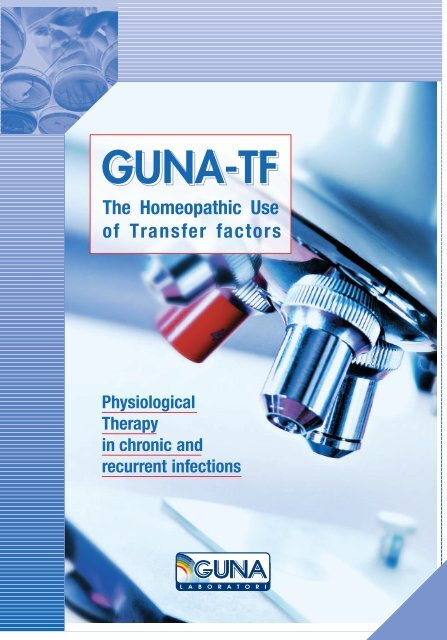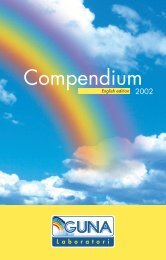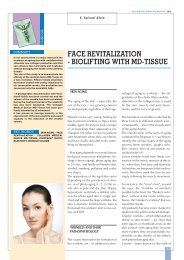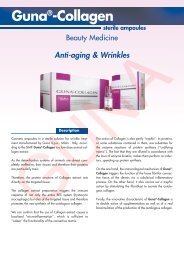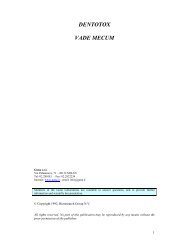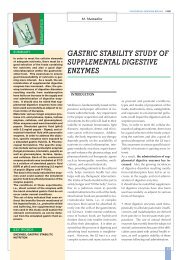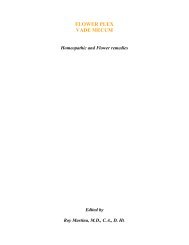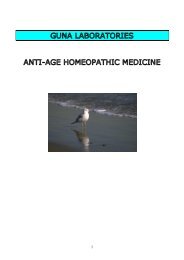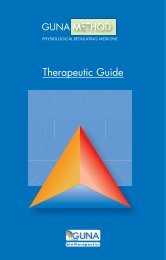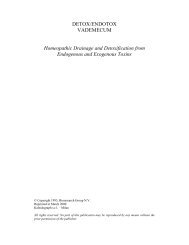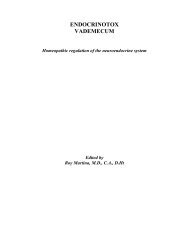You also want an ePaper? Increase the reach of your titles
YUMPU automatically turns print PDFs into web optimized ePapers that Google loves.
By Guna ® S.p.a. Scientific Department© Copyright 2006 Guna ® S.p.a.
<strong>GUNA</strong>-<strong>TF</strong>WHAT ARE<strong>GUNA</strong>-<strong>TF</strong>?<strong>GUNA</strong>-<strong>TF</strong> are Transfer Factors protein-based innovative homeopathicmedicines at D7 (7 X for US Physicians) potency (10 -7 ).The Transfer Factors are therapeutically active at a dosage of 100ng/day; to obtain this specific concentration (corresponding to theamount of Transfer Factors that are contained in a Guna-<strong>TF</strong> capsule),the technique of homeopathic preparation has been used in order torealize a standard production according to current GoodManufacturing Practice.Transfer factors are short ribonucleopeptide chains with antigenicmessenger RNA bases connected with short peptide chainscomposed of 6 or more amino acids. In simple words, they are tinymolecules providing for immune defence. They are all naturalsubstances that work by “teaching” our own immune system toidentify infectious agents that attack our body every day.Guna-<strong>TF</strong> are manufactured through a patented procedure byextracting them from lymph cells activated by specific antigens(viruses, yeasts, etc.).These Lymphoid lines are being cultivated in vitro and dialysed: inthis way, the so-called DLE (Dialyzable Leukocyte Extract) can becontaining over 200 molecules, weighting between 1.000 and20.000 Dalton. Among these, there are Transfer Factors proteinsresponsible for the transfer of cell-mediated immunity.
<strong>GUNA</strong>-<strong>TF</strong><strong>GUNA</strong>-<strong>TF</strong> MECHANISMOF ACTIONOne of the most common theories on the mechanism of action ofTransfer Factors is that they are part of the receptor lying on the Thlymphocyte surface in a steric position that is necessary to identifythe specific antigenic agent.Administering Transfer Factors proteins means activating themechanisms of receptor re-synthesization (specific receptors of aspecific antigen) by Th lymphocytes, thus enhancing their receptorcapacity and hence their immune effectiveness.Transfer Factors are also capable of activating intracellmechanisms responsible for the production of cytokines, which areimportant intracell communication messengers between differentimmune response intermediates. In particular, they activate thesynthesis of pro-inflammatory interleukins (for instance IL1, IL6,TNF, INF, etc) which are essential to induce an effectivephysiological response towards a pathogen agent.
COMPLEMEN<strong>TF</strong>ACTORS
<strong>GUNA</strong>-<strong>TF</strong>FOR WHICH DISEASES CAN<strong>GUNA</strong>-<strong>TF</strong> BE USED?The chronicization and recurrence of an infectious disease representthe most evident sign that the Immune System has been attacked bypathogen agents.Transfer Factors struggle against the body non-response by providing itwith the necessary factors to help the Immune System face the antigenattack.Guna-<strong>TF</strong> treatment is capable of transferring the immune pathway ofthe donor of Transfer Factors to the patient to be treated to trigger anautologous response that has to be sufficient and suitable to fight theantigenic attack in a physiological way.The treatment with Guna-<strong>TF</strong> is suitable in the forms of cell-mediatedimmune selected deficit.The response is specific only toward the antigen codifying the TransferFactor:• Herpes simplex type 1 and 2 · Guna-<strong>TF</strong> Herpes• Monilia albicans · Guna-<strong>TF</strong> Candida• HPV · Guna-<strong>TF</strong> Papilloma
Transfactor: Key notes➡100 ng/die = quantity of Transfer Factors proteins that are therapeuticallyactive and correspond to the quantity of <strong>TF</strong> D7 (7 X for US Physicians)in a capsule of Guna-<strong>TF</strong>➡Transfactor = Transfer of cell-mediated immunity➡Transfactor = Antigen-specific immunotherapy➡<strong>GUNA</strong>-<strong>TF</strong>➡ Transfactor = Physiological treatment of chronic recurrentinfections diseases➡ Transfactor = Effective and risk-free treatmentHOW TO USE <strong>GUNA</strong>-<strong>TF</strong>:• Guna-<strong>TF</strong> are in capsules for oral use.• Standard dosage: 1 capsule/day for 5 continuous days (forinstance: from Monday to Friday, excluding Saturday and Sunday)for 3-4 months without break.PACKAGE SIZEBottle of 20 x 230 mg capsules.
<strong>GUNA</strong>-<strong>TF</strong> HERPES<strong>GUNA</strong>-<strong>TF</strong> HERPESCompositionTransfer Factors-HSVtype 1 and 2 at D7 potency(7X for US Physicians).IndicationsHerpes labialis and Herpes genitalisrecurrent infections; herpetickeratoconjunctivitis; herpetic-likecutaneous infections.Dosage1 capsule/day for 5 continuous days (for instance:from Monday to Friday, excluding Saturday and Sunday)for 3-4 months without break.Package sizeBottle of 20 x 230 mg capsules.Combination with other Guna medicines:· Strengthening of immune defenses in Herpes simplex I and II infections:Guna-<strong>TF</strong> Herpes + Guna-Virus
Clinical casePrevention of recurrent labialand genital herpes infectionsA clinical research study has been carried out on 44 patients, 22 affected by labial herpes and 22affected by genital herpes.All the patients have been treated for 6 continuous months with a Transfer Factor preparationobtained from in vitro culture extract of specific HSV 1 and 2 from dyalized bovine lymphocytes.In the monitoring period before the treatment (the 44 patients have been monitored globally 26.660days long) there have been 544 reacutizations with a 61.2 Relapse Index.The monitoring period during and after treatment has been of 16.945 days for the 44 patients. Inthis period there have been 121 reacutizations with a 21.4 Relapse Index.From Pizza G, Viza V, De Vinci C, Palareti AP, Cuzzocrea DE, Fornarola V & Baricordi OR. “Orally administered HSV-specifictransfer factor (<strong>TF</strong>) prevents genital and/or labial herpes relapses”. Biotherapy, Vol. 9:62-72, 1996.
<strong>GUNA</strong>-<strong>TF</strong> CANDIDA<strong>GUNA</strong>-<strong>TF</strong> CANDIDACompositionTransfer Factor Monilia albicansat D7 potency(7X for US Physicians).IndicationsRecurrent Candida infections;mucocutaneous yeast problemsin different body areas; dermatitis.Dosage1 capsule/day for 5 continuous days(for instance from Monday to Friday,excluding Saturday and Sunday) for 3-4 months without break.Package sizeBottle of 20 x 230 mg capsules.Combination with other Guna medicines:· Acute and chronic Vulvo-vaginites as a consequence of yeast problems(Candidiasis):Guna-<strong>TF</strong> Candida + Mycox TM + Citomix TM (20 drops three times/day for 1 month)· Dysbiotic Candidiasis: Guna-<strong>TF</strong> Candida + Eubioflor TM + Citomix TM(20 drops three times/day for 2 months)
Clinical caseGuna-<strong>TF</strong>-Candida in chronicmucocutaneous CandidiasisA clinical research study has been carried out on 15 patients (3 M; 12 F) affected by ChronicMucocutaneous Candidiasis (6 patients with oral Candidiasis and 9 patients with VaginalCandidiasis).The patients have been treated with a Transfer Factor preparation from in vitro culture extract ofMonilia albicans. The CMI (Cell-Mediated Immunity) has been considered through the LeukocyteMigration Test (LMT) and the Lymphocyte Stimulation Test (LST) with the presence of Candidiasis lysatebefore, during and after treatment.83.9% of LMTS Test were positive during treatment, showing an increased incidence of Candidiasisantigen reactivity.In the monitoring period improvements of the health condition have been recorded.From Masi M., De Vinci C., Baricordi O.R. “Transfer Factor in chronic mucocutaneous candidiasis”. Biotherapy. 9(1-3)97-103, 1996.
<strong>GUNA</strong>-<strong>TF</strong> PAPILLOMA<strong>GUNA</strong>-<strong>TF</strong> PAPILLOMACompositionTransfer Factor Papillomavirusat D7(7 X for US Physicians) potency.IndicationsRecurrent Papillomavirus infections;condylomatoses; post-surgicalcondyloma treatment; warts.Dosage1 capsule/day for 5 continous days(for instance from Monday to Friday,excluding Saturday and Sunday) for 3-4 months without break.Package sizeBottle of 20 x 230 mg capsules.Combination with other Guna medicines:· Strengthening of immune defenses in Human Papilloma Virus (HPV)infections: Guna-<strong>TF</strong> Papilloma + Citomix TM
Clinical caseUse of <strong>TF</strong>-Papilloma in HPV diseaseA clinical research study has been carried out on 160 patients, both male and female, affected byHPV (Papilomavirus) lesions or PAP test or biopsy positive to koilocytosis to consider the results of atreatment with Transfer Factor preparation from in vitro culture HPV extract to prevent relapses.The protocol provided for the use of one capsule/day for 5 continuous days/week for 8 weeks andthen one capsule/day for 3 days/week (on alternate days) for another 4 weeks.The viral HPV lesions have almost disappeared in the patients treated.In 97% of the cases where the electrosurgical treatment has been used in conjunction with thepreparation no further persistent symptoms of disease have been recorded.From M. Destro Castaniti. “L'utilizzo del Transfactor 11 nella patologia virale da HPV (casistica di 160 casi)”. La MedicinaBiologica, 2000/4; 95-100.
<strong>GUNA</strong>-<strong>TF</strong>Literature references1. Blume M.R., Rosenbaum E.H., Cohen R.J.,Gerhow J, Glassberg AB, Shepley E. -Adjuvant immunotherapy of high risk stageI melanoma with transfer factor. Cancer,47, 882-888, 1981.2. Borden E.C. - Augmented tumour-associatedantigen expression by interferons. JNCI,80, 148-149, 1988.3. Bukowski R.M., Deodhar S., Hewlett J.S.,Greenstreet R. - Randomized controlled trialof transfer factor in stage II malignant melanoma.Cancer 51, 269-272, 1983.4. Conti F., Orlandini A. - Trattamento di manifestazioniallergiche con Transfer Factor(<strong>TF</strong>). La Medicina Biologica, 1998/3; pp.35-39.5. Corrado F., Pizza G., De Vinci C., CorradoG., Mannini D., Maver P., Ferri C., AielloE. - L'impiego del transfer factor nel carcinomaprostatico metastatizzato. In Atti delConvegno Internazionale sul Cancro dellaProstata. Garofalo F, Tomaselli V Eds. MonduzziEditore, Bologna. p. 89-92, 1988.6. Corrado F., Pizza G., De Vinci C., CorradoG. - Il trattamento con transfer factor dellemetastasi ossee da adenocarcinoma dellaprostata. In: Le Metastasi, Atti XII CongNaz Oncol, Saccani F, Becchi G, CarrettiD, Maltoni C Ed, Monduzzi Editore, Bologna,1233-1235, 1986.7. Corrado F., Pizza G. - Tentativas de inmunoterapiaen los tumores del aparato urinario.Arch Esp Urol, 37, 659-666, 1984.8. Destro Castaniti M. - L'utilizzo del Transfactor11 nella patologia virale da HPV (casisticadi 160 casi) - La Medicina Biologica2000/4, pagg. 95-100.9. Fudenberg H.H., Fudenberg H.H. - TransferFactor: Past, present and future. Annu RevPharmacol Toxicol, 29: 475-516, 1989.10. Fudenberg H.H., Smith C.L. - Immunomodulationand immunotherapy: an overview ofbiologic and synthetic agents and theireffects on the human immune system. EOSRiv. Immunol Immunopharmacol, 1: 3-11,1981.11. Fudenberg H.H., Wilson G.B. et al - DialyzableLeucocyte Extracts (Transfer Factor): Areview of clinical results and immunologicalmethods for donor selection, evaluation ofactivities and patient monitoring. In:Thymus, Thymic Hormones and TLymphocytes. Eds: Aiuti F, Wigzell H. ProcSerono Symp, Academic Press, London,38: 391-421, 1980.12. Fudenberg H.H., Wilson G.B., Tsang K.Y.- Evaluation of transfer cator potency andprediction of clinical response. In: Immunomodulation:New Frontiers and Advances.Eds: Fudenberg H.H., Whitten H., AmbrogiF. Plenum Press, New York, pp.115-130, 1984.13. Fusjisawa T., Yamaguchi Y., Kimura H. et al- Adjuvant immunotherapy of primary resectedlung cancer with transfer factor. Cancer,54, 663-669, 1984.14. Gonzalez R.L., Wong P., Spitler L.E. - Adjuvantimmunotherapy with Transfer Factor inpatients with melanoma metastatic to lung.Cancer, 45, 57-63, 1980.15. Greiner J.W., Fisher P.B., Pestka S., SchlomJ.: Differential effects of recombinant humanleukocyte interferon on cell surface antigenexpression. Cancer Res, 46, 4984-4990,1986.16. Huo B. - Clinical application of TransferFactor in China.ibidem pp. 451-459.17. Jones J.F., Minnich L.L., Jeter W.-S., Pritchett,Fulginiti V.A., Wedgwood R.J. - treatment ofchildood combined Epstein-Barr virus/cyto-
megalovirus infection with oral bovine transferfactor. Lancet 2: 122-124, 1981.18. Jones J.F., Pizza G., De Vinci C. - Infectiousmononucleosis: immunotherapy with EBVspecificTransfer Factor? J Exp Pathol, 3(4),399-406, 1987.19. Kirkpatrick C.H. - Transfer Factor - Perspectivein human and veterinary medicine. J ExpPathol, vol 3(4), 383-398, 1987.20. Lawrence H.S. - Proc. Soc. Exp. Biol Med71, 516, 1949.21. Malzac J. - Applicazioni terapeutiche deiTransfer-factors nella prassi clinica quotidiana:prime esperienze e risultati clinici - La MedicinaBiologica 1997/2 Supplemento, pagg.50-54.22. Malzac J. - Transfer Factor, specifica attivazionedella memoria del linfocita - La MedicinaBiologica 1996/2 Supplemento, pagg. 46-50.23. Mazzella G., Ronchi M., Villanova N.,Mohamed A.A., Pizza G., De Vinci C., VizaD., Roda E., Barbara L. - Treatment of chronicB virus hepatitis with specific Transfer Factor. JExp Pathol, 3, 421-423, 1987.24. Meduri R., Campos E., Scorolli L., De VinciC., Pizza G., Vizà D. - Efficacia del TransferFactor nel trattamento di pazienti con infezionierpetiche oculari ricorrenti. In: “Biotherapy”9/1996.25. Neequaye J., Viza D., Pizza G., Levine P.H.,De Vinci C. et al - Specific Transfer Factorwith activity against Epstein-Barr virus reduceslate relapse in endemic Burkitt's lymphoma.Anticancer Res, 10,: 1183-1188, 1990.26. Nkrumah F.K., Pizza G., Neequaye J., VizaD., De Vinci C., Levine P.H. - Transfer Factorin prevention of Burkitt's Lymphoma relapses.J Exp Pathol, 3, 463-469, 1987.27. Orlandini A. - Il Transfer Factor: la proteinaresponsabile del trasferimento della reattivitàcellulo mediata verso antigeni specifici - LaMedicina Biologica 1996/2; pagg. 37-42.28. Paddock G.V., Wilson G.B., Lin F.K.,O'Leary, Fudenberg H.H. - In: Electrophoresis'81, Eds: Allen R, Arnaud P. Edited by DeGruyter, NY, pp. 479-486, 1981.29. Pizza G., Viza D., Ablashi D.V., Faggioni A.,Armstrong G., Levine P.H., De Vinci C., InnocentiR. - Transfer of reactivity with in vitro producedTransfer Factor in Rhesus and Owlmonkeys. Lymphokine Res, 4, 351-357,1985.30. Pross HF, Baines M. - Studies of human naturalkiller cells. I. In vivo parameters affectingnormal cytotoxic function. Int J Cancer, 29,383-390, 1982.31. Roda E., Pizza G., Viza D., Mastroroberto L.,De Vinci C., Barbara L.: Transfer Factor forthe treatment of HBsAg positive chronic activehepatitis. Proc Soc Biol Med (Usa), 178,405-410, 1985.32. Sasakawa S., Takenouchi K., Masumoto C.,Mura T., Saito S et al: Clinical trials of dialyzableleukocyte extract (RC<strong>TF</strong>-I) in Japan. In:Leukocyte Dialyzates and Transfer Factor, EdsMayer V, Borvak, pp.141-145. Inst Virol, SlovakAcad Sci, 1987.33. Schwartz R.S., Jeter W.S. - Oral-administrationof human dializable transfer factor in apatient with psoriasis. Arch Dermatol, 117:3-4, 1981.34. Viza D., Rosenfeld F., Phillips J., Vich J.M.,Denis, Bonissent J.F., Dogbe K. - Specificbovine transfer factor for the treatment of herpesinfections. In: Immunobiology of TransferFactor, Kirkpatrick CH, Burger DR, LawrenceHS Eds, Ac Press, NY, 245-259, 1983.35. Viza D. - Transfer Factor: un immunomodulatorenella lotta contro le malattie infettive -
Literature referencesLa Medicina Biologica 2000/4, pagg.31-37.36. Viza D., Orlandini A. - Il Transfer Factor specifico(<strong>TF</strong> 11) nel trattamento delle affezionimuco-cutanee da Papillomavirus (HPV) - LaMedicina Biologica 1999/3, pagg. 11-15.37. Whyte R.I., Schork A., Sloan H., OrringerM.B., Kirsh M.M. - Adjuvant treatmentusing for bronchogenic carcinoma: longtermfollow-up. Ann Thorac Surg 53, 391-6, 1992.38. Wilson G.B., Fudenberg H.H. - Is controversyabout “transfer factor therapy” nearthe end? Immunol Today. 4: 157-161,1983.39. Wilson G.B., Jonsson H.T., Halushka P.V.,Garner B.P., Berkaw M.N. - Contribution ofprostaglandins to the biological activity ofDyalizable Leukocytes Extracts containingTransfer Factor. Ibidem, pp.137-150.40. Wilson G.B., Metcalf J.F. jr., FudenbergH.H. - Treatment of Mycobacterium fortuitumpulmonary infection with Transfer Factor:New methodology for evaluating <strong>TF</strong>potency and predicting clinical response.Clin Immunol Immunopathol, 23, 478-491, 1982.41. Wilson G.B., Paddock G.V., FudenbergH.H.: Bovine “Transfer Factor”: an oligoribonucleopeptidewich initiates antigen-specificlymphocyte responsiveness. Thymus,4: 335-350, 1982.42. Wilson G.B., Paddock G.V., FudenbergH.H.: Effect of dialyzable leukocyte extractswith transfer factor activity on leukocytesmigration in vitro. V. Antigen-specificlymphocyte responsiveness can be iniatedby two structurally distinct polyribonucleotides.Thymus 2: 257-276, 1981.Contact UsFor USA customers<strong>GUNA</strong> Incorporated1520 Tramway Blvd. NE, STE, 150Albuquerque, New Mexico 87112, USA1-888-<strong>GUNA</strong>-TEL (486-2835)1-888-<strong>GUNA</strong>-FAX (486-2329)Contact your Medical Sales Consultant directly at: 505-217-3977or fax to 505-217-3996Please give us your opinion and feedback by emailing us at info@gunainc.comFor all other countries outside the United StatesPlease email us at export@guna.it
<strong>GUNA</strong> S.p.a.Via Palmanova, 71 – 20132 MILAN - ITALYTel. +39 02 28018.1 - Fax +39 02 2822234Internet: www.guna.it - e-mail: export@guna.itwww.gunainc.comA/10.07


